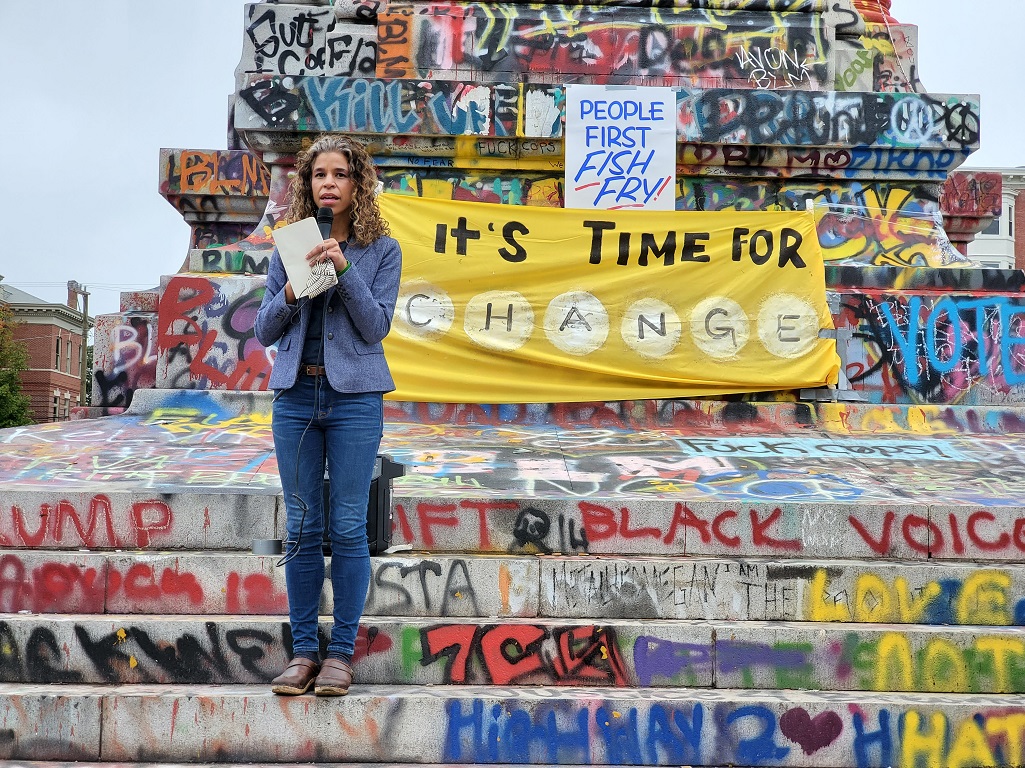Richmond Third District School Board candidate Kenya Gibson has come under fire in the run-up to her election campaign. To Richmond community organizers Monique Drake and Brionna Nomi, the critiques are misleading and disingenuous.
At a time when people in Richmond and across the country are awakening to issues of systemic racism and racial injustice, leaders of color are standing up to represent the voices of their communities and serve as bold, undiluted agents of change. However, progressive Black leaders who dare to address and eradicate historic inequities face blowback from moneyed interests who seek to maintain their power, status and privilege. Kenya Gibson, who serves as the Third District School Board Member in Richmond, is one such leader.
Kenya Gibson is the most consistent and stalwart progressive elected official Richmond City has to offer. During her tenure, Kenya and supporting board members successfully fought for the construction of three new schools without closing or consolidating existing schools. Kenya has secured more free speech protections for teachers and fought to improve teacher retention, a longstanding problem within the city. Kenya successfully sought to protect funding for Richmond Public Schools and helped to defeat the costly $1.5 billion real estate tax-funded Dominion Coliseum redevelopment plan. She pushed the School Board to adopt good governance policies that promote transparency, engagement, and a needs based budget.
Yet despite Kenya Gibson’s substantive record – or, arguably, because of it — a group of parents, many aligned with the policies and initiatives of Mayor Stoney, are positioning themselves as “integrationists” and challenging Kenya. The “integrationists” accuse Kenya, a consistent progressive champion in her community and a woman raised by a white mother and a Black father, of supporting the Confederacy, opposing LGBTQ rights, and opposing school integration. This effort is a strategy devised by political interests on behalf of the elite establishment.
Certainly, there are some good faith actors who differ with Kenya’s policy choices. However, these individuals are not the driving force behind the campaign against her.
In the era of Black Lives Matter, BIPOC communities — using their voices and with a sense of agency — articulate a vision of racial justice that combats systems and policies of oppression. Black Richmonders such as Kenya have a conception of racial justice that includes removing Confederate monuments and names, but they don’t allow the conversation to stop there. Kenya has spoken out against new prisons and argued for the removal of police from schools. She has pushed for an understanding of racial justice that moneyed interests and wealthy donors don’t like. Kenya has pushed for progressive taxation — raising taxes on the wealthy with an eye towards promoting high-quality fully funded schools, secure housing, robust transportation, and other public services.
A people of color-centered justice movement has been hijacked and misappropriated by some white liberals who wish to center themselves and their own needs without authentically engaging with Black communities. Often it is those with privilege who have access to resources and power in our society who benefit most from a more superficial understanding of racism. Non-profits reliant on funding from the wealthy can often reproduce a superficial understanding. Who benefits when racial justice is not about policy and systems, but rather about symbols or individuals engaged in self-help? Often, it’s professional-class white liberals who then get to feel good about themselves while ultimately leaving the power structure intact. In the end, their actions work against the very values they claim to champion.
Many of those engaged in this attempt to smear Kenya are supporters of Mayor Stoney and the Navy Hill Development/Dominion Coliseum proposal that Kenya helped defeat. Mayor Stoney has contributed to and endorsed Kenya’s opponent. Others are white parents newer to the district, who don’t seem to fully grapple with the contradiction of demands that the school system be responsive to their racial justice analysis in the absence of a well-funded broader inclusive process, where all parents are engaged. It’s a context where the form of racial justice can lose the content.
Examining the specific accusations made against Kenya reveals how deliberately misleading her detractors have been.
Cindy Menz-Erb, an ally of Mayor Stoney who lost to Kenya in a 2017 special election, wrote an email to an exclusive group of Third District parents making outlandish and categorically false assertions. The same assertions later appeared on a flyer for the suspicious and newly formed “Northside Parents Collective.” We know that these items would be disturbing if true, so they’re worth debunking.
For starters, Kenya’s detractors have accused her of being pro-Confederate because she was the lone vote against the renaming of J.E.B. Stuart Elementary — named for a Confederate general — in honor of Barack Obama. The context behind Kenya’s vote is that she wanted more time to consider renaming the school after local Richmond leaders, such as civil rights attorney Oliver Hill, or Albert Norrell, who was one of the first Black principals in Richmond. Kenya’s position echoed that of longtime community members who spoke out against the renaming process.

Critics also accused Kenya of anti-LGBTQ+ sentiment for opposing a revised student dress code, which was more equitable for gender nonconforming students, within the Student Code of Responsible Ethics (SCORE). Kenya in fact supported the changes to the dress code for LGBTQ+ students, but voted against the SCORE document because it failed to address disciplinary procedures that, in practice, criminalize normal childhood behavior.
Further, Kenya is accused of being an integration foe because she opposed pairing, a severely flawed model for school integration. As part of Richmond’s rezoning process, Superintendent Jason Kamras and some school board members pushed the idea of school pairing as a strategy for creating a more diverse student body. Under pairing, a school district takes a majority-white school and a majority-Black school, both of which serve Kindergarten through 5th grade, and pools the students. One of the schools is then assigned to the K-2 students in the pool, and the other school to grades 3-5.
The pairing idea for Kenya’s Third District — actually a tripling — would have combined three K-5 schools: Linwood Holton Elementary, which has a 55 percent Black and 45 percent white student enrollment, and Barack Obama Elementary and Ginter Park Elementary, both of which are more than 90 percent Black. The plan would have turned Obama and Ginter Park into K-2 schools, and Holton into a 3-5 school.
It is true that pairing had some support from parents legitimately interested in racial justice. That acknowledged, pairing is a model that is in conflict with what we know are best practices for education. Public education advocates have pushed for a community schools model precisely because it promotes parental involvement. Pairing would have made parental involvement more difficult for those families who don’t have access to transportation and who work jobs that don’t afford them flexibility — in other words, the burdens of pairing would have fallen heavily upon Black working-class families. The Charlotte-Mecklenburg School District is one of the only school districts in the country that has attempted pairing. The superintendent who pushed it there, Clayton Wilcox, was suspended and ultimately resigned over a pattern of racist and sexist remarks. Parents have spoken out about the effect of pairing disproportionately burdening working-class families
Superintendent Kamras falsely characterized pairing as a method of integration and likened those who had concerns about pairing to racist Jim Crow segregationists. Ultimately, he was unable to convince any school board member to back a pairing effort in their own district, yet tried to put Kenya on the spot and force the plan in Northside. Community members saw Superintendent Kamras pushing a policy lacking a track record and characteristically short on details, such as costs and what transportation would look like. Also lacking was data on the long-term impact the transition of pairing would bring on already traumatized and stressed children. Worst of all, white parents were centered in the discussions on pairing, while Black parents were misled, delayed, or altogether kept out of the process.
Here is a point we must emphasize: While integration must be understood as a tactic of achieving racial justice, integration itself is not necessarily a racial justice silver bullet. At the time of Brown v. Board of Education, integration was a tactic the NAACP used to intervene in the various components of white supremacist infrastructure. Their strategy was not based on the notion that the habits of poor Black people could only improve if they were exposed to the “middle-class” values of white people, or that diversity is a valuable pedagogical device. Rather, the NAACP understood the dynamics of white supremacist budget priorities that “separate but equal” school districts for white and Black students made it politically impossible for Black students to receive the necessary funding.
This should be instructive then in identifying the criteria to evaluate whether integration efforts are advancing racial justice and representing the transformation we need. Who does it place as the central protagonist? Does it reproduce existing power relations or transform them? Does it result in more overall funding for schools? Does it result in a gain in the resources being spent on students of color?
Kenya has stood up for parents, students, and teachers against an initiative she viewed as lacking in transparency, poorly thought through, and lacking consideration of the perspective of educators, as well as a significant representation of RPS parents. Kenya has extensively experienced and considered the role racism plays in schools, and remains a stalwart advocate of integration done well, led first and foremost by the communities integration is supposed to serve. Her commitment to racial justice is reflected in her endorsements by The Richmond Crusade for Voters, Justice and Reformation for Marcus-David Peters, Richmond For All, and others.
Kenya Gibson is what real social justice leadership looks like: substance over symbolism. She has won funding for students, supported community schools as a formula for success, defeated efforts that infringe on democratic governance, and made Black Lives Matter at Richmond Public Schools. Since Kenya’s positions are popular, adversaries attempt to challenge her with harmful statements and false accusations. We see through it, and we are confident voters in the Third District will as well.
Note: Op-Eds are contributions from guest writers and do not reflect editorial policy.
Top Photo: Kenya Gibson speaking at a Justice & Reformation Fish Fry at Marcus-David Peters Circle. Photo by Kristin Reed.



